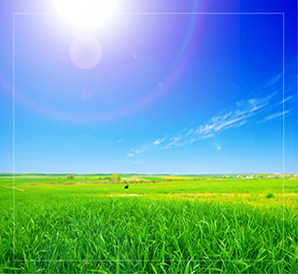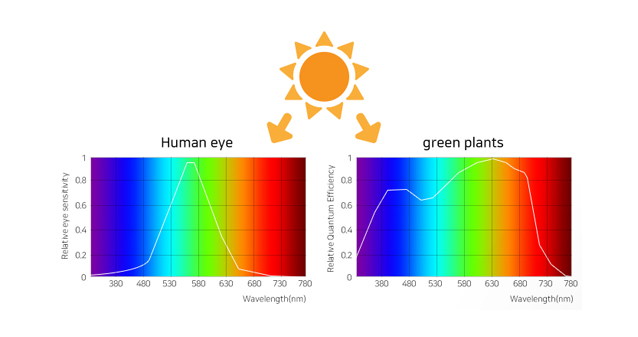PLANT-GROWING LED CONTENTS
- What is a plant-growing LED?
- Physiological response of plants according to the wavelength of light
- Light required by plants
- Differences in light recognized by humans and plants
- Bissol Plant-growing LED Characteristics
- Comparison of Regular Fluorescent Lamp and LED Plant-growing Lamp
- light saturation point & light compensation point by crops
- What is a plant-growing LED?
-
Humans can distinguish between light and dark and color by sensing light in
the 380 nm to 780 nm range, but plants physiologically react according to the wavelength of light.
It is useful lighting for plant growth utilizing blue light with wavelength of 400nm ~ 500nm and
red light with wavelength of 640nm ~ 700nm which helps plant photosynthesis. By using LED semiconductor
characteristic intrinsic wavelength, unlike ordinary light, it produces only 450nm and 660nm light which
helps plant growth, except for light of 500nm ~ 640nm which does not contribute much to photosynthesis.
It is the lighting that can be used as a substitute for sunlight in a plant factory for the supplemental lighting of sunlight in facility cultivation. and it is a product realized in the visible light excluding the ultraviolet (UV) part harmful to the human body and the infrared (IR) part involving the heat, which is not harmful to the human body or the plant. 
- Physiological response of plants according to the wavelength of light
-
빛의 파장에 따른 식물의 생리 반응 Wavelength(nm) Action effect Infrared ray IR-A 1400 ~ 1000 No special effect on photosynthesis. Heat generated by heat rap 780 Promote growth Visible ray Red 700 Germination prevention(730), Maximum photosynthesis action(670) 660 Maximum chlorophyll action(655), Germination action/ Leaf development flower bud formation(660) Reddish yellow 610 Not beneficial to photosynthesis, Pest control(580~650) Greenish yellow 510 Partial absorption due to yellow pigment blue 430 ~ 440 Maximum of photosynthesis action: Leaves grow wider and bigger, Stem growth suppressed Ultraviolet ray UV-A 400 ~ 315 Generally, thicken leaves of plants. A function to promote the coloring of pigment. Attraction insect pests UV-B 280 Forming immune system: functional substance content increases UV-C 100 Chlorophyll destruction
- Light required by plants
-
 Photosynthetically active radiation Flux Density (PPFD) represents the amount of photosynthetic photon flux density falling for 1 second per 1 square meter. Photosynthetically active radiation Flux Density (PPFD) is a quantification of the amount of light required by a plant. and it is impossible for a person to judge the degree of PPFD visually and evaluate it. In general, the brightness of light is based on the view when viewed by human eyes, and the brightness at that time is referred to as Luminance, and while lx (lux) is used as a unit representing the brightness, μmol/㎡s is used as a unit for representing photosynthetic efficiency of plants. The active radiation flux density is measured using a spectral luminometer and the photon density between 400 nm and 700 nm is measured. The shorter the wavelength, the greater the energy of light particle, and the red PPFD value is larger than the blue one when the energy amount of the same light is used as a reference
Photosynthetically active radiation Flux Density (PPFD) represents the amount of photosynthetic photon flux density falling for 1 second per 1 square meter. Photosynthetically active radiation Flux Density (PPFD) is a quantification of the amount of light required by a plant. and it is impossible for a person to judge the degree of PPFD visually and evaluate it. In general, the brightness of light is based on the view when viewed by human eyes, and the brightness at that time is referred to as Luminance, and while lx (lux) is used as a unit representing the brightness, μmol/㎡s is used as a unit for representing photosynthetic efficiency of plants. The active radiation flux density is measured using a spectral luminometer and the photon density between 400 nm and 700 nm is measured. The shorter the wavelength, the greater the energy of light particle, and the red PPFD value is larger than the blue one when the energy amount of the same light is used as a referenceDifferences from Lux Lux (Lux) is the derived unit of the candela (Cd), and PPFD is the derived unit of mole That is, Lux is a measure of pure light intensity, and PPFD is a measure of the number of photons useful for plant photosynthesis.
- Differences in light recognized by humans and plants
- Plants have a different sensitivity to light than humans For example, humans are most sensitive to green light, but plants are sensitive to a broader range of light wavelengths, mainly blue and red, which is closely related to photosynthesis
-
Growth light sources are one of the most important elements for photosynthesis
In the wacelength range of 400~700 nm, photon number per second is called photosynthetic activity radiation(par*), which is expressed in micromol / s(µmol/s)
* Photosynthetic Active Radiation 
- Bissol Plant-growing LED Characteristics
-
Monochromatic light expression necessary for photosynthesis and plant growth
Since it is an inherent wavelength in LED semiconductor characteristics, it is effective for plant growth and can implement precise wavelength (Blue: 450nm / Red: 660nm), 100% color purity, and excellent plant growth effect. - Possible to purchase customized products Supports 1:1 customized light source according to the cultivation environment, provided by adjusting the ratio of red light source and blue light source according to the cultivation environment
- Shortening of plant growth period and adjustable flowering time Shorten the plant growth period, and increase the harvest of farmers as cultivation is possible throughout the year, controlling the flowering time of various plants is possible by adjusting the amount of light.
- High efficiency Three times more red (650 mn) light emission than fluorescent light/Electricity charge and carbon reduction effect: 50% saving Except for the initial purchase cost of the LED bulb, the electricity cost reduction effect is excellent and the life span is semi-permanent
- Comparison of Regular Fluorescent Lamp and LED Plant-growing Lamp
-
Comparison of Regular Fluorescent Lamp and LED Plant-growing Lamp Regular Fluorescent Lamp LED Plant-growing Lamp 1 Wavelength No red peak at 660nm Fabrication to match optimum ratio of plant-growing blue (450nm) and red (660nm) waves. 2 Converter Converter needed. Directly connected to AC with response to a wide range of voltage. 3 Power Consumption High Low power consumption to save power (50% or more) 4 Environmentally Harmful Matters Emits mercury, lead, greenhouse gas (CO2). Eco-friendly products, reducing greenhouse gas emissions 5 Life 5,000~10,000 hours 50,000 ~ 100,000 hours or more 6 Hazards May break (glass tube). Uses aluminum and polycarbonate materials that have no risk of breaking.
- light saturation point & light compensation point by crops
-
light saturation point : The amount of photosynthesis of plants is proportion to PPFD and rises only to a certain point, which is known as the light saturation point.
light compensation point: Organism can grow larger than this value -
light saturation point & light compensation point by crops Plant growth LED lamp light saturation point light compensation point lx ppfd lx ppfd Tomato, Watermelon 9317 847 396 36 Cucumber 7315 665 264 24 Garden Bean 5324 484 264 24 Lettuce, Pepper 3322 302 198 18 Grape 5324 484 55 5 Tangerine 5324 484 27.5 2.5 Pear 5324 484 39.6 3.6 Peach 5324 484 55 5 Fig 5324 484 132 12 Saint flir 660 60 66 6 Orchids 1331 121 39.6 3.6 Cyclamen 1991 181 39.6 3.6 Ginseng 1595 145 66 6